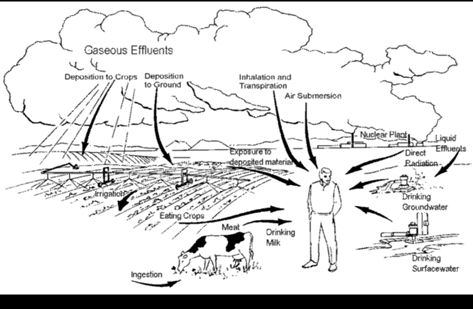Exposure Pathways and Routes
Exposure Routes
Once a chemical, physical or biological agent reaches us, the exposure route is the way it enters our body. The three major exposure routes to humans are:
- Inhalation
- Ingestion
- Dermal contact
Other exposure routes are placental exposure of a fetus, exposure to noise, and eye exposure to ultraviolet (UV) radiation.
Exposure Pathways
The exposure pathway is the physical course an environmental agent takes from its source to those who eventually receive it. For example, agricultural use of pesticides may contaminate crops, the soil, and the air. Some pesticide remains on crops when they are harvested and distributed. Eventually, the food (and the pesticide) are ingested by a human.

The illustration below summarizes a variety of possible exposure pathways.

Image source: http://www.atsdr.cdc.gov/hac/pha/PHA.asp?docid=78&pg=2
A key aspect of an exposure pathway investigation is a determination of how people in a community might come into contact with a chemical. In an exposure pathways evaluation, five main elements are considered:
- Contaminant source: Place where the chemicals originated or were released
- Environmental fate and transport
- Specific location(s) where people may come in contact with a chemical in the environment
- Exposure route: How the contaminants enter one's body (inhalation, ingestion, dermal absorption)
- Estimate of the number of potentially exposed people


